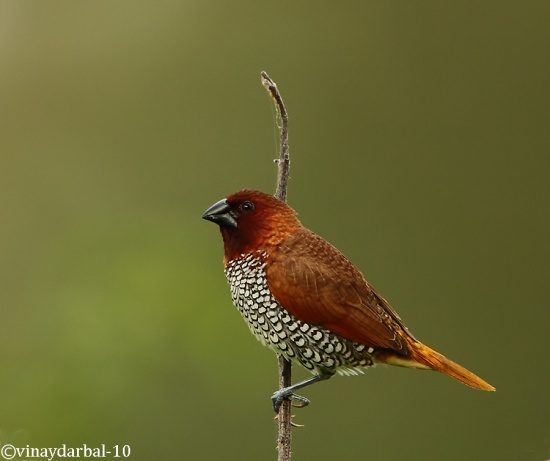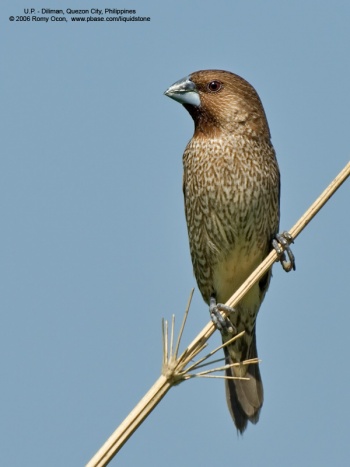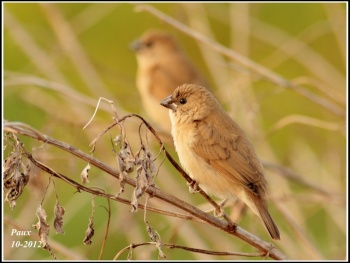Alternate names: Nutmeg Mannikin, Spice Finch, Spotted Munia
- Lonchura punctulata
Identification
10–12½ cm (4-5 in)
Adult: both sexes identical with cinnamon-brown back and head, at least sometimes with darker face and throat. The breast and the rest of the underside is mostly white with each feather showing narrow borders and stripes in brown producing a scaly pattern. Pattern varies with the subspecies. Sometimes scales are single, sometimes doubled on each feather. Also varies in extent of scaling in the throat area.
Juvenile is slightly lighter than the adult on the back, while the underside is buffy, gradually lighter towards undertail coverts and lacking in the scaly effect. Bill is black in both adult and juveniles.
Similar Species
Juveniles are similar to juvenile Chestnut Munia, but distinguished by Scaly-breasted's black rather than bluish bill.
Distribution
The natural distribution is from Nepal through India and Sri Lanka and east from there through China and the far east to Philippines and Indonesia.
In addition, this species is common in the pet trade, and has generally established populations that spreads from wherever escapes have happened. They are therefore present along the east coast of Australia, the Caribbean and the USA, just to mention a few of the locations where they have been introduced.
Taxonomy
Twelve subspecies share the original range. Birds in the pet trade are unlikely to come from any single subspecies, so introduced populations likely represent a mixture; even so, birds in Australia and the Caribbean do not look identical.
Subspecies
There are 12 subspecies[1]:
- L. p. punctulata: Nepal to Sikkim, India and Sri Lanka
- L. p. subundulata: North-eastern India (Assam) to Bhutan and western Myanmar
- L. p. yunnanensis: North-eastern Myanmar and south-western China
- L. p. topela: Southern China to northern Thailand, Indochina, Hainan and Taiwan
- L. p. cabanisi: Philippines (Luzon, Mindoro, Panay, Cebu, Calauit and Palawan)
- L. p. fretensis: Southern Thailand and Malay Peninsula to Sumatra and adjacent islands
- L. p. nisoria: Java, Bali, Lombok and Sumbawa
- L. p. sumbae: Sumba (Lesser Sundas)
- L. p. blasii: Flores, Timor, Tanimbar Islands and adjacent Lesser Sundas
- L. p. particeps: Sulawesi
- L. p. baweana: Bawean Island (Java Sea)
- L. p. holmesi: Southeast Borneo (Kalimantan)
Habitat
Lowland open areas with seeding grass. Has been observed at heights around 900m (3000 ft) on the approach to the Himalayas in Himachal Pradesh.
Behaviour
Normally occur in flocks.
Diet
Their main diet consists of grass seeds and rice grains.
Breeding
Nest is a loosely constructed ball with a low side entrance. Outside made of flowering grass heads, leaves and twigs. Internal chamber lined with fine grass. Occasionally will use old nest of another bird. Clutch is 3-6 eggs with larger clutches suspected of being the result of two or more females laying in the same nest. Nesting can occur at any time of the year if conditions are favourable, and the nest is normally found at moderate height in a bush or tree.
Vocalisation
Scaly-breasted Munia sound clip
Recording by Alok Tewari
Gurgaon Rural, Haryana, India January-2015
A flock sitting on dry Acacia branches making faint calls and flies away.
The communication calls were very faint. They were made while sitting and also when birds flew away.
Movements
Mostly resident with local movements in response to ripening grain.
Gallery
Click on photo for larger image
Nominate subspecies adult and young mixed group
Photo © by Alok Tewari
Dist. Gurgaon, Haryana, India, 13 January 2015
References
- Clements, J. F., T. S. Schulenberg, M. J. Iliff, S. M. Billerman, T. A. Fredericks, B. L. Sullivan, and C. L. Wood. 2019. The eBird/Clements Checklist of Birds of the World: v2019. Downloaded from http://www.birds.cornell.edu/clementschecklist/download/
- Payne, R. (2020). Scaly-breasted Munia (Lonchura punctulata). In: del Hoyo, J., Elliott, A., Sargatal, J., Christie, D.A. & de Juana, E. (eds.). Handbook of the Birds of the World Alive. Lynx Edicions, Barcelona. (retrieved from https://www.hbw.com/node/61187 on 28 January 2020).
- Clement, P., A. Harris, and J. Davis. 1993. Finches and Sparrows: An Identification Guide. Princeton Univ. Press, Princeton, N. J.
- Pratt, H.D., Bruner, P., and Berrett, D.G. (1987) A Field Guide to the Birds of Hawaii and the Tropical Pacific. Princeton University Press.
- Pyle, R.L., and P. Pyle. 2017. The Birds of the Hawaiian Islands: Occurrence, History, Distribution, and Status. B.P. Bishop Museum, Honolulu, HI, U.S.A. Version 2 (1 January 2017) http://hbs.bishopmuseum.org/birds/rlp-monograph/
Recommended Citation
- BirdForum Opus contributors. (2025) Scaly-breasted Munia. In: BirdForum, the forum for wild birds and birding. Retrieved 26 April 2025 from https://www.birdforum.net/opus/Scaly-breasted_Munia
External Links
GSearch checked for 2020 platform.1









